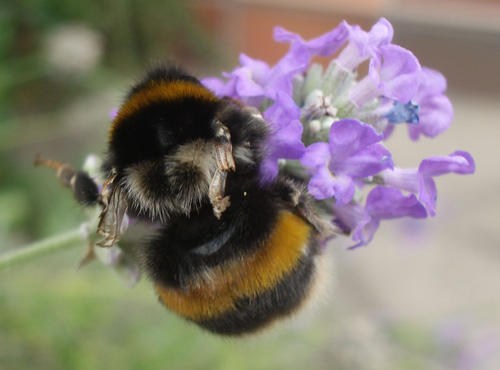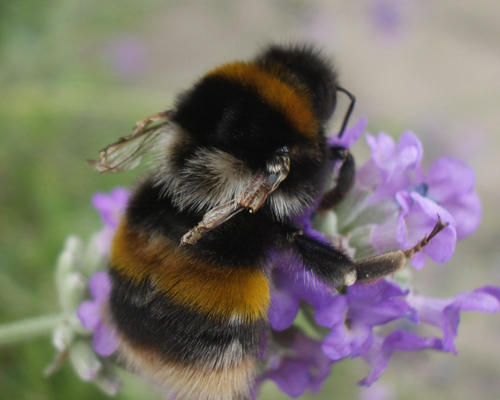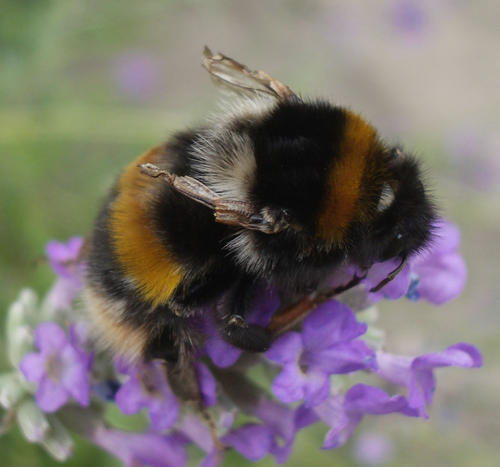Bumblebee Bombus terrestris apparently infected with Deformed Wing Virus (DWV)
Jacqueline Hartwright
[compiled from emails and other information by the Editor]
On 05/08/2011 Jacqueline Hartwright wrote:
‘I wonder if you can help me? I first spotted the wingless bumblebee Bombus terrestris on the lavender bush in my front garden on Monday. Despite the rain yesterday, the bee is alive and on the lavender today. I think the lavender will be over in a few days, so I don’t hold out any hope of its survival. It seems that it can see, as I moved it to a flower that wasn’t dying and it later scrambled across other stems to another flower head. Chris Betts thought it could be Deformed Wing Virus. Have you any suggestions?’ This note was accompanied by pictures (Figs. 1, 2, &3.).
To which I replied:
I have to admit this is a new one on me and I am not a bee-keeper! However, an internet search quickly revealed a great deal of information on Deformed Wing Virus (DWV) as it is a serious disease of Honey Bees associated with Varroa mites. For instance Genersch et al. 2006 state in the summary of their paper:
‘Honey bees Apis mellifera infected with Deformed Wing Virus (DWV) through Varroa destructor during pupal stages develop into adults showing wing and other morphological deformities. Here, we report for the first time the occurrence of bumble bees Bombus terrestris, Bombus pascuorum exhibiting wing deformities resembling those seen in clinically DWV-infected honey bees.. Since such deformed bumble bees are not viable DWV infection may pose a serious threat to bumble bee populations’.
Furthermore the virus has also been found to affect bumblebees in many parts of the world, see for example Jilian Li et al. (2011) who state:
‘The Deformed Wing Virus (family Iflaviridae, genus Iflavirus, DWV), one of the most prevalent and common viruses in honey bees, Apis mellifera L., is present in both laboratory-reared and wild populations of bumble bees, Bombus huntii Greene’.
Request for records and information.
A great deal of other information is available in worldwide bee-keeping and scientific literature. The main purpose of this note is to encourage readers to look out for bumblebees with deformed wings in Worcestershire. If possible take pictures and send them to Harry Green zen130501@zen.co.uk. From a conservation point of view the virus could reduce bumblebee populations, already under threat because of habitat loss. If any reader has more knowledge and experience of DWV I should be pleased to hear from them and to receive information for a later Worcestershire Record.
References
Genersch, E., Yue, C., Ingemar, F. and de Miranda, J. B. 2006. Detection of deformed wing virus, a honey bee viral pathogen, in bumble bees (Bombus terrestris and Bombus pascuorum) with wing deformities. J. Invertebr. Pathol. 91:61–63.
Jilian Li, Wenjun Peng, Jie Wu, James P. Strange, Humberto Boncristiani, and Yanping Chen. 2011. Cross-Species Infection of Deformed Wing Virus Poses a New Threat to Pollinator Conservation. Journal of Economic Entomology 104(3):732-739. http://dx.doi.org/10.1603/EC10355
Images
Fig. 1. Bumblebee probably afflicted by Deformed Wing Virus. Jacqueline Hartwright
Fig. 2. Bumblebee probably afflicted by Deformed Wing Virus. Jacqueline Hartwright
Fig. 3. Bumblebee probably afflicted by Deformed Wing Virus. Jacqueline Hartwright


